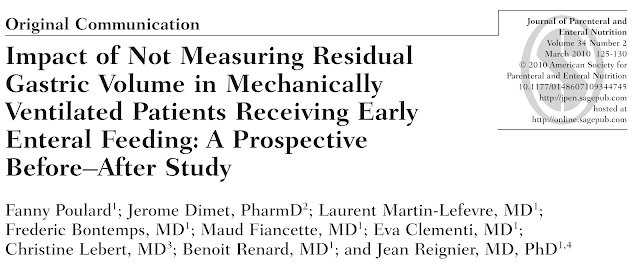Do you as a nurse spend any part of your day checking for residual tube feeds on your patients who are on mechanical ventilation and receiving tube feeds/enteral feeding? Did you know that since 2016, the ASPEN guidelines have recommended against this? Now may be your opportunity to present this data to the powers that be and let you have your time back so you can “play cards” (obvious joke) and do more important things in patient care. It’s 2019, think of all the time you’ve spent partaking in this practice. Sigh. Okay don’t think about it. We NEED you at the bedside. In the McClave study there was no support for using residual volumes as a marker for the risk of aspiration. the frequency was 21.6% vs 22.6%. The Poulard study from 2010 was calling checking residual gastric volume “standard practice”. I guess that’s why some institutions are still doing it. They wanted to do the study because there was no data to find a correlation between residuals and adverse events. Know what they found? That not checking residuals allowed for a greater daily volume of enteric feeds. No difference in vomiting between the two groups nor was there a difference in ventilator associated pneumonia. Worth it to check residuals? Still not convinced? Lets look at more data then. Last but definitely not least, the Reignier study in 2013, 3 years after the 2010 study showed that there wasn’t a benefit to checking residuals (in all fairness the study took place in 2010) looked at ventilator associate pneumonia as the primary endpoint. Did they find a difference? They found a whole bunch of NOPE. Does that settle the argument in your mind? Yes, I know that we all had that ONE patient who aspirated and got sick. It’s not perfect. But the data is there, actually, right here. Three articles that you can obtain on my website. A little literature review from me, if you will. Hope you got something out of it and your time will now be saved. Share this with your nurse managers, dietitian teams, and fellow nurses so everyone can benefit.
I’m sorry that I can’t get you these articles as they are hidden behind the dreaded paywall but the ASPEN guidelines are free. Hopefully this helps you not check for residual tube feeds.
For more data on ICU nutrition: CLICK HERE
-EJ

Reignier, J. (2013). Effect of Not Monitoring Residual Gastric Volume on Risk of Ventilator-Associated Pneumonia in Adults Receiving Mechanical Ventilation and Early Enteral Feeding. JAMA, 309(3), 249.
McClave, S. A., Lukan, J. K., Stefater, J. A., Lowen, C. C., Looney, S. W., Matheson, P. J., … Spain, D. A. (2005). Poor validity of residual volumes as a marker for risk of aspiration in critically ill patients*. Critical Care Medicine, 33(2), 324–330.
Poulard, F., Dimet, J., Martin-Lefevre, L., Bontemps, F., Fiancette, M., Clementi, E., … Reignier, J. (2009). Impact of Not Measuring Residual Gastric Volume in Mechanically Ventilated Patients Receiving Early Enteral Feeding. Journal of Parenteral and Enteral Nutrition, 34(2), 125–130.
Although great care has been taken to ensure that the information in this post is accurate, eddyjoe, LLC shall not be held responsible or in any way liable for the continued accuracy of the information, or for any errors, omissions or inaccuracies, or for any consequences arising therefrom.


